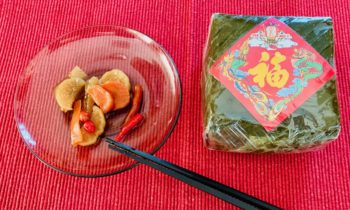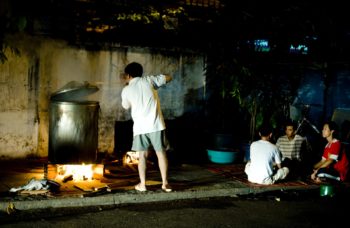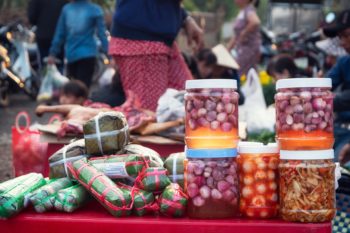Bánh Chưng – A Traditional Lunar New Year Food Posted by Kandle Dart on Feb 8, 2021 in Culture, Foods, Vocabulary

Photo taken and used with permission from Trung Quach
Bánh Chưng (square sticky rice cake) is the signature traditional food of Tết (Vietnamese NewYear). Without bánh Chưng, Tết would lose its essence! This beloved food has long been a tradition, with a history that extends far back to the Hong Bang period thousands of years ago.
According to legend, the 6th Vietnamese king of the Hong Bang dynasty, held a cuisine search contest among his twenty-one sons. The contest winner would become the next ruler. Lang Liêu (also known as Tiết Liêu), the poor eighteenth son, with help from a fairy in his dream, created two types of cakes, one of which was bánh Chưng made in a square shape that represents the Earth. Impressed by this delectable cake, the King passed his throne to the eighteenth son. Since then, bánh Chưng became an essential traditional food for Tết, a must offering item on the ancestor worship altar and on the Tết’s meals.
The Art of Making Bánh Chưng
Here are the ingredients:
- Gạo nếp (glutinous rice)
- Đậu xanh (mung bean)
- Thịt heo (pork meat)
- Muối (salt) & tiêu (pepper)
- Lá dong (dong leaves) or lá chuối (banana leaves)
- Dây lạt (bamboo fibers)
Though it looks quite simple and is not a fancy food, the process is very time consuming and it takes experience to make it look and taste right.
The glutinous rice, mung bean, and the bamboo fibers have to be soaked in water 6-8 hours before making. Stuff the pork meat, and mung bean right in the middle of the uncooked glutinous rice, then tightly wrap it with the banana leaves in a perfect square shape. Delicately tie the cake evenly with the fibers stripped from the bamboo stalk. The whole process requires experience and skill. It takes between 8-14 hours to boil the cakes in the traditional way. Finally, it needs to be pressed after being cooked to remove the excess water.
A good bánh Chưng is one that still has a perfect square shape after being cooked. Once unwrapped, it should have a natural, nice green color, be tender but not mushy, and of course, taste amazing.
Who would have time to spend a whole day and a whole night to make this? Well, it’s the work of a whole family. In the old days, family members would gather together to make bánh Chưng on Lunar New Year’s eve and cook it while waiting for the count down. Making bánh Chưng is a family tradition, a special time for parents to tell old stories, gossip, and bond with their family members.
How to Serve
After unwrapping, reuse the bamboo fibers that tied the bánh Chưng to slice the cake into smaller square sections to serve. No knife is needed. It does take skill to evenly slice the cake with straight, clean cuts. Once you tire of eating the boiled bánh Chưng or it becomes stale, you can fry it in a pan to make it crunchy on the outside but sticky and chewy inside for a special treat. Indeed, children often prefer to eat bánh Chưng chiên (fried bánh Chưng).
What goes along with bánh Chưng in a traditional Tết’ meal? Don’t forget these condiments and dishes:
- Thịt đông (Cold fatty pork stew) or thịt kho (warm pork stew)
- Giò lụa (rolled pork ham)
- Dưa kiệu (Pickled leeks)
- Dưa cải (Pickled mustard green)
- Dưa hành (Pickled onions in fish sauce)
These foods are so popular that they are memorialized in a very well known câu đối tết (Tết distich)
Thịt mỡ, dưa hành, câu đối đỏ (Fatty meat, pickled onions, red color distich)
Cây nêu, tràng pháo, bánh chưng xanh (Bamboo pole, firecrackers, green bánh Chưng)

Build vocabulary, practice pronunciation, and more with Transparent Language Online. Available anytime, anywhere, on any device.






